- Benefits of Streamlining Your Employee Onboarding Process
- The Old Ways of Onboarding New Employees
- Automate New Hire Onboarding Processes
- Turn Paper to Digital with HR Onboarding Software
- Set and Schedule Training Programs
- Have Role and Responsibilities for Your Team
- Tip: Communicate the Importance of Culture
- Digitize Your Onboarding Process for New Hires
Onboarding new employees is arguably the most important part of your business operations. This process sets the stage by introducing new hires to the company and brand vision while arming them with the tools necessary to be successful in their new roles. Yet many companies (especially smaller businesses) lack a streamlined digital onboarding process.
This is a shame considering onboarding is your first (and could very well be your last) impression on new employees. Contrary to what many believe, onboarding doesn’t start on day one.
It starts at the first application (or even an invite to apply), and it should continue seamlessly through the employee’s entire career. The 2019 Jobvite Job Seeker Nation Survey found 24% of candidates give up on an application process because of system issues while 29% of workers left a job within the first 90 days.
We live in an era of mobile connectivity, where prospective job candidates can apply to big businesses like Bank of America or Amazon on a job board, the company’s website, social media platforms like LinkedIn and Twitter, or even text message or chatbot. This is becoming the new norm in a modern society that needs instant gratification.
A recent survey of HR professionals from Paychex Worx reinforces the importance of a solid onboarding experience by pointing out the top three priorities for HR: evaluating workplace productivity, training and developing staff, and driving results through company culture. The seeds for these key ingredients are planted through HR onboarding the day a new hire applies.
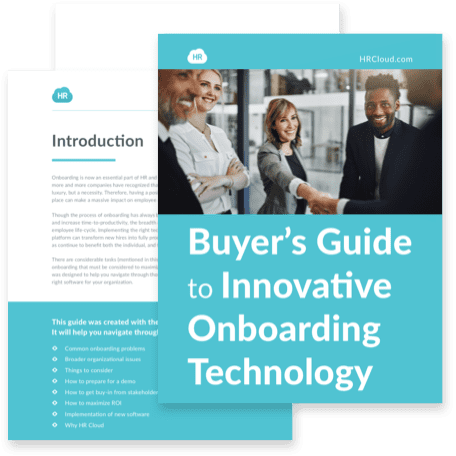
This guide was designed to help you navigate through those difficult tasks and help determine the right software for your organization, download our ebook now.
Download nowBenefits of Streamlining Your Employee Onboarding Process
Onboarding a new employee is easier said than done. An employee number needs to be assigned to issue an ID badge and any necessary logins. Payroll needs to be set up within specific banking deadlines. Training materials need to be distributed and tax forms filled out. There are a lot of moving parts involved, and any wrench in the machine can cause massive delays.
By the time an employee finishes training, he or she needs to be able to easily and efficiently log in to every business system. From there, trainers teach new hires the basics of navigating those systems and performing required job duties at competent levels.
Technology plays a key role in today’s industry and HR processes are no different. It starts at the application process in today’s candidate-driven market. Streamlining this process can save a lot of headaches down the road.
It costs an average of 21% of an employee’s annual earnings to recruit, hire, train, and onboard a replacement. This means replacing an employee who makes $20 per hour costs $8,736 while replacing one who makes $200k a year costs $42,000. These are expensive investments to make without a solid, streamlined process in place for onboarding new employees.
The Old Ways of Onboarding New Employees
The first step in any hiring process used to be placing a ‘help wanted’ sign on the window and an ad in the classifieds section of the newspaper. Prospective candidates would call or come in to fill out an application, test, and all sorts of paperwork to be scheduled for their first day.
Day one consisted of—that’s right—more paperwork.
Orientation is the first part of any successful corporate training program, and that means acclimating new hires to the company culture. Thick (often color and/or laminated) paper training manuals are handed out to the team, along with job aids, process and procedures, and more.
Tracking progress in this old system was archaic. All necessary information needed to be forwarded up the ranks to management and HR and manual follow-ups were necessary during the new hire onboarding process. If something went wrong, an employee could be delayed on gaining access to the work environment or getting paid. Each can be a mini catastrophe if not solved quickly.
This was the case for businesses lucky enough to have training staff and resources—small businesses were stuck training when other team members had time, which left new employees lost or confused for much of the day. No attention was paid to the employee experience in outdated HR onboarding, which led to many employees either quitting or failing to meet standards in their job duties.
Automate New Hire Onboarding Processes
Thankfully, there are technology tools available to automate the new employees' onboarding process. Streamlining this process prioritizes the time of both existing employees and new hires to ensure full-time equivalent headcount requirements are met for the business units while saving HR time in tracking down progress.
Automating everything from job postings and responses all the way through the onboarding pipeline gives HR a clear vision of every stage of the employee onboarding program. Technology provides a personalized experience to new employees while making it easier for HR to schedule follow-ups with recruiters, department managers, and training staff.
With an automated HR platform, businesses not only save time and money on new hire onboarding, but they also reduce employee turnover. A recent Gallup poll found six out of ten millennials are open to new job opportunities, and no business can afford that large portion of young professionals dropping out due to key steps missed during the employee onboarding training program.
HR Analyst of Osmose Utilities Services, Inc
“Our hiring managers now have a reliable system that is easy to navigate. Our HR team can actively monitor the process, and assist if needed, but Onboard has helped them save so much valuable time and effort while increasing data accuracy. All of this has helped us improve compliance and gives us a powerful tool to achieve even more results in the future.”
Turn Paper to Digital with HR Onboarding Software
Implementing employee onboarding software creates a seamless, paperless environment that centralizes the process of onboarding new employees. This allows for at-a-glance analysis and one-click reporting on individual employees or entire training classes as they move through the process.
Going green in HR means turning paper into digital throughout the entire recruiting, hiring, and training process. A quality platform can work with existing systems and data formats to create a seamless journey from new hire to employee to retiree. There are three key areas HR onboarding software optimizes:
1. Automated Email Notifications
Automated email notifications should be set up when new hires pass specific thresholds or landmarks. This keeps all stakeholders abreast of the employee’s development. Remember that it’s not just HR who’s invested—management and the employee himself has a stake in this development process.
Using a centralized HR platform enables automated email notifications based on key triggers. If a deadline is coming up, employees can be reminded to take a test or turn in an assignment. HR can be notified to follow up, as can management. This helps all stakeholders optimize schedules and workloads to accommodate.
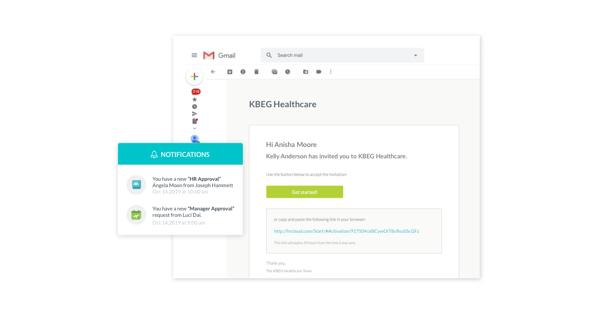
2. Set-Up Workflows
Onboarding new employees is a multi-step process, much like progressing through a university degree program. Building a scalable HR process requires repeatable processes that can accommodate multiple new-hire classes in multiple departments, simultaneously. Workflows make an assembly line process out of creating top-tier employees.
With a centralized platform in place, it’s easy for the C-suite to immediately see a high-level view of how many applications, interviews, and follow-ups are missing in the recruitment and hiring process. Employee training can then happen across the board, not just for new hires, as continuous learning is important for employees of all tenures.
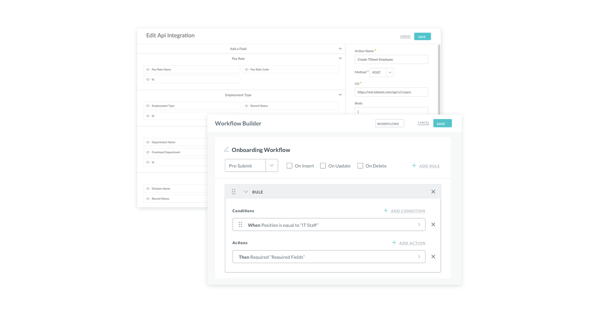
3. Digital Form Compliance
Another pain point that an HR onboarding platform streamlines is digital form compliance. Signed employment contracts, tax declarations, insurance/benefits forms, and direct deposit information all need to be collected and input as soon as possible to ensure payments are made on time. Imagine how long a new hire is sticking around for a company that can’t pay on time.
Digital form compliance keeps businesses in line with all federal, state, and local employment laws and regulations. This protects the company against audits, lawsuits, and other potentially damaging expenses. The last thing any company needs is to be asked by a judge or the IRS for paperwork and receipts that don’t exist—it’s a one-way ticket to getting shut down.
By digitizing these formerly paper-based processes, HR platforms cut a company’s waste by going green. This saves money and reduces the errors caused by manual work, and that’s just the start.
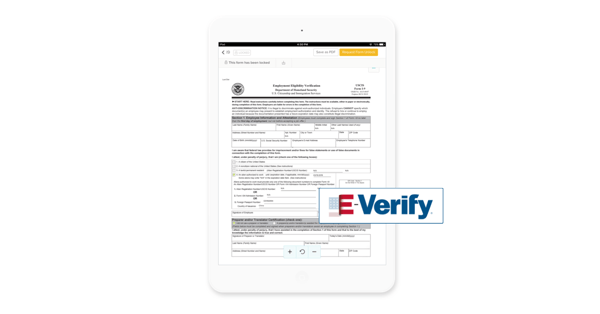
Check out our blog to learn more about how HR Cloud digitizes the onboarding process for new hires.
Set and Schedule Training Programs
With HR onboarding software, you don’t have to manually schedule training anymore. In fact, a coded calendar makes it easy to find available training staff, rooms, and workstations for training. This includes both in-classroom learning with side-by-side monitoring and on-the-job training.
Easily train new employees without overwhelming them and gamify the process to motivate success. During onboarding, employees should understand department and individual key performance indicators (KPIs) like quality and production. Career progression and learning about other internal processes ensure new hires have a holistic view of their role.
HR onboarding software makes it possible to have set training for different positions, interweaving classes whenever necessary. Orientation, for example, can be shared among all teams, as it is company-wide information. By day two or three at the latest, everyone should be attending department/role-specific training.
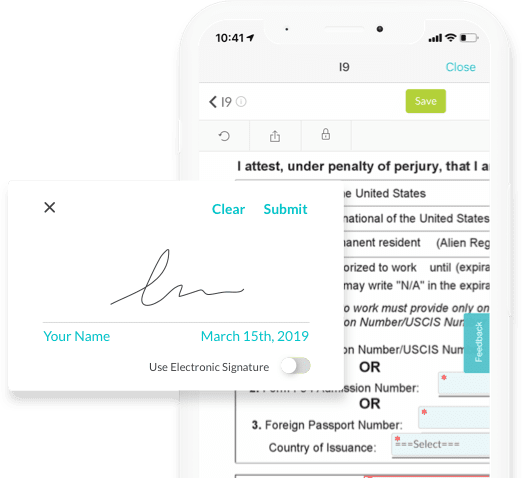
Have Role and Responsibilities for Your Team
Even large enterprises need to know who will take part in new employee onboarding. Trainers need to be scheduled, along with subject matter experts (SME) who can assist with on-the-job training (OJT). Management and organizational leaders need to make time to greet new hires to acclimate them to the new environment.
All this operational work takes time off the production floor and must be scheduled in advance so the company doesn’t fall out of compliance or miss customer orders. It’s important not to skip, though. The average number of jobs held in a person’s career is double today what it was 20 years ago. This means employees are more likely to quit if they don’t feel engaged at work.
Building a solid support network for new hires accomplishes two things: it instills confidence in the new employee to start producing like a veteran, and it gives tenured employees an opportunity to show their leadership abilities. Great leaders are measured in the success of their subordinates, so pinpointing multiple successful employees to one coach or mentor means someone could be due for a merit-based promotion.
HR Cloud can handle role assignments and scheduling. There are also automated reminders that notify people/departments to complete tasks, like reminding IT to set up a new hire's computer or accounting to set up direct deposit. These clear, organized tasks are centralized onto one role-based platform, making it easy for all business units to work cohesively on new hire onboarding.
Check out our blog to learn more about how to assign and organize roles and responsibilities among your team in order to streamline your process for onboarding new employees.
Tip: Communicate the Importance of Culture
Each touchpoint in the onboarding process needs to communicate your company culture and, as mentioned earlier in this blog, this includes the application process, the first-day welcome kit and all the way through to an employee’s retirement. From day one through their last day, employees expect and deserve a consistent, branded experience just like customers.
Company culture is at the heart of why people choose to work for (or do business with) a company. A major technology conglomerate like Google or Apple needs to have company cultures that inspire and motivate employees to strive for success at all levels. These companies are expected to have the latest technology while providing a comfortable work environment that feels like working at a much smaller company.
A culture of indifference is what inevitably leads to corruption. It’s a lesson society continues learning as companies like Enron, WorldCom, Countrywide, and Theranos collapse amidst scandal and allegations of unlawful activity. Repetitive reinforcement of company culture from the application process through retirement is the key to building a sustainable future for your company.
Digitize Your Onboarding Process for New Hires
Onboarding new employees is a multi-step process that’s often overlooked, especially in smaller companies. Even when an organization invests in onboarding, many manual, paper-based processes are still in use to this day. That’s a lost opportunity at a time when businesses are expected to have more green initiatives.
A digitized and centralized HR platform can handle the onboarding process as an automated workflow, enabling scalable training solutions for companies of all sizes. HR, training staff, all levels of management, and the employees are all kept in the loop on progression through the application, orientation, new-hire paperwork, systems access, and job training.
With a centralized platform in place, onboarding new employees is optimized for efficiency. Scheduling resources and assigning employees to assist in the process is intuitive and the platform can adapt to accompany an employee from day one through retirement.
Download our latest whitepaper to learn how to improve the employee onboarding process from start to finish.
Keep Reading
Importance of Onboarding: Purpose, Benefits, and What It Means for Your Workplace
Think about the last time you joined a new team. You had questions, maybe even doubts.
The Ultimate Guide to a Smooth Employee Onboarding Process in 2025
You can also listen to this blog

